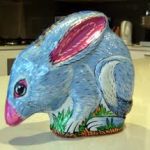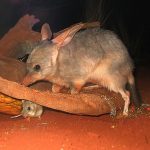That’s The Way The Easter Bilby Goes – Cluas i ndiaidh Cluaise (using the Irish verb “to eat”)! Posted by róislín on Apr 10, 2012 in Irish Language
(le Róislín)
Some of you might remember our brief discussion of “An Bilbí Cásca” last year when we were talking about Máirt Chásca as a lá saoire bainc? Where is that extra bank holiday, which none of the rest of us get, observed? “Bilbí” is a bit of a clue — sa Tasmáin! I say “a bit of clue” since apparently, bilbies are not currently found on the island of Tasmania, but only in northern and western Australia. I’m not actually sure if they ever lived in Tasmania. A Astrálacha? A zó-eolaithe? An bhfuil a fhios agaibh? So the reference to “an Tasmáin” there was only a nod toward mórthír na hAstráile.
Anyway, while Seachtain na Cásca is still in it, let’s revisit the Easter Bunny consumption theme (cluas i ndiaidh cluaise), but this time with the bilby instead. The original version, as you may recall, was at https://blogs.transparent.com/irish/that’s-the-way-the-easter-bunny-goes-–-cluas-i-ndiaidh-cluaise-using-the-irish-verb-“to-eat”/ . But first, let’s look at all the forms of the word “bilbí” in all its glory, séimhiú, urú, and all:
an bilbí, the bilby. It’s a 4th-declension noun, so there’s relatively little change.
an bhilbí [un VIL-bee], of the bilby (cluas an bhilbí, the ear of the bilby)
bilbithe [BIL-bih-huh], bilbies
na bilbithe, the bilbies
na mbilbithe [nuh MIL-bih-huh], of the bilbies (cluasa na mbilbithe, the ears of the bilbies)
You might also recall that last time we worked on this, we were also looking at verb forms in various tenses (aimsirí, i.e. present, past, future) for relative clauses (the child who …, the child whose sister …, etc.). A final note is that I’ve changed one anatomical term for discussing bilbies. For the rabbit, I used the word “lámhóid” (a rabbit’s forepaw), but for the bilby, I’d use the more generic “lapa” (paw). Anyway, here goes:
1) An aimsir láithreach (present): Itheann an páiste cluas an bhilbí seacláide (the child eats the ear of the chocolate bilby).
Direct relative: Seo é an páiste a itheann cluas eile an bhilbí seacláide (This is the child who eats the other ear of the chocolate bilby).
Indirect relative: Seo é an páiste a n-itheann a dheirfiúr súile an bhilbí seacláide (This is the child whose sister eats the eyes of the chocolate bilby).
2) An aimsir chaite (past): D’ith an páiste ruball an bhilbí seacláide (The child ate the tail of the chocolate bilby)
Direct: Seo é an páiste a d’ith lapaí an bhilbí seacláide (This is the child who ate the forepaws of the chocolate bilby).
Indirect: Seo é an páiste ar ith a dheartháir cosa deiridh an bhilbí seacláide (This is the child whose brother ate the hind legs of the chocolate bilby).
3) An aimsir fháistineach (future): Íosfaidh an páiste guaillí an bhilbí seacláide (The child will eat the shoulders of the chocolate bilby).
Direct: Seo é an páiste a íosfaidh cabhail an bhilbí seacláide (This is the child who will eat the torso of the chocolate bilby).
Indirect: Seo é an páiste a n-íosfaidh a chol ceathar na blúirí seacláide atá fágtha sa bhosca a raibh an bilbí seacláide ann.
And, as we exclaimed last time while reading that last sentence, “A thiarcais!” That sentence (the “indirect” example) has trí chlásail choibhneasta, not unusual for an Irish sentence, but a little convoluted to read. Here’s the translation:
This is the child whose cousin will eat the crumbs of chocolate that are left in the box that the chocolate bilby was in.
If I were to be really rigorous with this, I’d be distinguishing between an bilbí mór (the greater bilby) and an bilbí beag (the lesser bilby), and likewise, cluas an bhilbí mhóir and cluas an bhilbí bhig, etc., but I think that amount of detail can wait for another blog, maybe next Lá Náisiúnta na mBilbithe. When’s that? Well, keep reading an blag seo and you’ll find out!
Furthermore, the bilbí beag is extinct, so I’d feel somewhat worse about eating one, even symbolically (i.e. in chocolate). The bilbí mór is a speiceas i mbaol and there are many efforts afoot to strengthen its status, like http://www.savethebilbyfund.com/ and the Australian Bilby Appreciation Society (http://members.optusnet.com.au/bilbies/). Currently there are only about 600 to 700 bilbies known to exist. Some of the proceeds from the chocolate bilbies are used to help preserve the species.
Next time I write about bilbithe, I’ll add a few academic references, which means I’ll be able to include a “bilbiography.” That’s an imeartas focal, which, like most, doesn’t translate well. What’s the Irish for a “bibliography” (the ordinary kind)? It’s simply “leabharliosta” (lit. booklist). But come to think of it, there is also the word “bibleagrafaíocht,” used more for the practice, art, and science of bibliography-making. So, a bhilbithe, you’ve got your chance, and your calling, a bheith in bhur mbilbleagrafaithe. Or to put it back in the perhaps more familiar singular (uneclipsed) form, “Is bilbeagrafaí mé,” a deir an bilbí (I’m a “bilbiographer,” says the bilby). Hmm, I’d better quit all this before I short-circuit my spell-checker.
So, sin é, maidir le bilbithe seacláide, don bhlag seo ar a laghad. Tá súil agam gur bhain tú sult as agus más amhlaidh go bhfuil tusa ar cheann de na daoine a bhfuil deis acu bilbí seacláide a ithe (.i. Astrálach, is dócha) tá súil agam go mbainfidh tú sult as sin chomh maith. Or if you’d had any interesting experiences with bilbies, real or chocolate, please do write in and let us know. Slán go fóill, Róislín

Build vocabulary, practice pronunciation, and more with Transparent Language Online. Available anytime, anywhere, on any device.






Leave a comment: